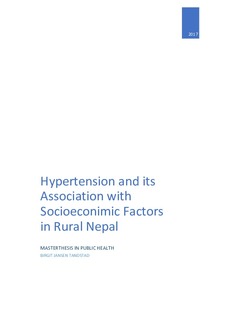| dc.contributor.advisor | Sen, Abhijit | |
| dc.contributor.author | Tandstad, Birgit J. | |
| dc.date.accessioned | 2017-09-22T12:58:24Z | |
| dc.date.available | 2017-09-22T12:58:24Z | |
| dc.date.issued | 2017 | |
| dc.identifier.uri | http://hdl.handle.net/11250/2456324 | |
| dc.description.abstract | Background: Hypertension is a major risk factor for cardiovascular diseases in all regions of the world. There is an increasing prevalence of hypertension and cardiovascular diseases in developing countries and this is no different in Nepal. Studies from many developed nations have suggested an association between lower socioeconomic status and higher prevalence of hypertension; however, in many developing countries, an association between high socioeconomic status and hypertension has been observed. The increase of hypertension has also been observed in rural areas in Nepal.
Study design: This is a Cross-sectional Study conducted in a primary health facility in rural Nepal.
Purpose: The purpose of this study is to estimate the prevalence of hypertension in a rural village in Nepal, and to determine the association between socioeconomic indicators (income, education and occupation), with hypertension. This has not yet been studied in this area of Nepal and this study will contribute information of prevalence of hypertension and socioeconomic factors in a rural health setting.
Method: This study was conducted among 260 participants at Kirneter health Center located in Dolakha district of Nepal. The study was conducted between October and December 2016. Information on sociodemographic, lifestyle, dietary, and other clinical history of each of the participants was collected using a standardized questionnaire. We measured systolic and diastolic blood pressure 2 times and then calculating each patients’ mean blood pressure as a measure for defining hypertension. Multiple logistic regression models was used to assess association of socioeconomic factors with hypertension.
Results: Prevalence of hypertension was 19.2% in this study. Participants who attained higher education, had higher income and those employed had higher odds of hypertension compared to those with lower education, low income or farmers. However, the result is not statistically significant.
Conclusion: We observed no clear evidence of positive association between higher socioeconomic status and hypertension among patients from Kirnetar health center. Future studies with larger sample size are needed to replicate our findings. | nb_NO |
| dc.language.iso | eng | nb_NO |
| dc.publisher | NTNU | nb_NO |
| dc.subject | Hypertension, income, education, occupation, sociodemographic factors, Nepal, South Asia, Low and middle income countries. | nb_NO |
| dc.title | Hypertension and its Association with Socioeconomic Factors in Rural Nepal | nb_NO |
| dc.type | Master thesis | nb_NO |
| dc.subject.nsi | VDP::Medical disciplines: 700::Health sciences: 800 | nb_NO |
